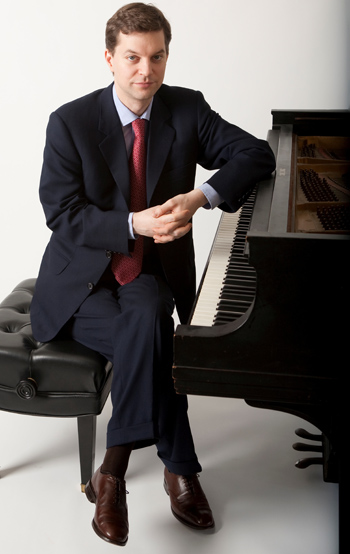Honeck and the Chicago Symphony recall Dvorak on native soil with a dancing Eighth
 Review: Chicago Symphony Orchestra. Manfred Honeck, conductor; Till Fellner, piano. At Orchestra Hall through Jan. 21. ****
Review: Chicago Symphony Orchestra. Manfred Honeck, conductor; Till Fellner, piano. At Orchestra Hall through Jan. 21. ****
By Lawrence B. Johnson
If Dvorak’s Ninth Symphony is a yearning postcard “From the New World,” his Symphony No. 8 in G major is redolent of a composer happily settled on native ground. The Eighth is decidedly of the Old World, as conductor Manfred Honeck and the Chicago Symphony Orchestra so generously demonstrated Jan. 19 at Orchestra Hall.
 Listening to the dance rhythms that underpinned every movement of the Honeck’s turn through the Eighth Symphony, whether supple and flowing or energetic and crisp, one could readily imagine country lads and girls in festive costumes stepping lightly on ground that had felt the stamp of their forebears. It’s an ancient fire that burns in this music, and long shadows dwell in its depths.
Listening to the dance rhythms that underpinned every movement of the Honeck’s turn through the Eighth Symphony, whether supple and flowing or energetic and crisp, one could readily imagine country lads and girls in festive costumes stepping lightly on ground that had felt the stamp of their forebears. It’s an ancient fire that burns in this music, and long shadows dwell in its depths.
The Austrian-born Honeck, music director of the Pittsburgh Symphony Orchestra, surely absorbed the soul and pulse of Dvorak’s art in the decade he spent playing both violin and viola with the Vienna Philharmonic and in the pit of the Vienna State Opera. From the CSO strings he drew a wonderfully express range of sound from ample warmth in the broadly paced slow movement to incisive brilliance in the finale.
That said, the conductor also pulled quite a surprise in rearranging the strings into a configuration that I had not seen before at Orchestra Hall. Besides dividing the violins with the firsts on his left and the seconds on his right – a widely preferred setup to accentuate voicing – Honeck relocated the double basses to his far left, roughly opposite their usual position on the right, behind the cellos. He also moved the cellos — to the inside, between the basses and violas. The resulting sound balances were fine, but I can’t say I heard an improvement from the orchestra’s conventional seating.
The Dvorak also profited from exquisite woodwind playing, notably in intimate interplay of winds that courses through the slow movement. Like the “New World,” the Eighth comes to a dazzling finish powered by an outpouring of brass sound. To Honeck’s particular credit, he kept a dynamic lid on the brassworks right up to the last hurrah before unleashing trumpets, trombones, horns and tuba in one riotous eruption.
Honeck harkened back to his days with the Vienna State Opera for his concert opener, Johann Strauss Jr.’s Overture to “Die Fledermaus.” This potpourri of tunes from the operetta also proved in this instance to be an amusingly indulgent pastiche of elongated phrases, distended rhythms and swooping dynamics. Call it an “instrumental” rather than “vocal” interpretation. It was a virtuosic show, and great fun.
 The Austrian pianist Till Fellner was the soloist in a provocative account of Beethoven’s Piano Concerto No. 1 in C major. At age 39, the pianist has an impressive history in the music of Beethoven: During the two-year stretch 2008-10, he performed the 32 sonatas in a seven recital series repeated in Vienna, Paris, London, New York and Tokyo. In this, his second appearance with the CSO following his debut in 2007, Fellner gave the impression of a consummate musician and a pianist of absolute accomplishment.
The Austrian pianist Till Fellner was the soloist in a provocative account of Beethoven’s Piano Concerto No. 1 in C major. At age 39, the pianist has an impressive history in the music of Beethoven: During the two-year stretch 2008-10, he performed the 32 sonatas in a seven recital series repeated in Vienna, Paris, London, New York and Tokyo. In this, his second appearance with the CSO following his debut in 2007, Fellner gave the impression of a consummate musician and a pianist of absolute accomplishment.
Interpretive choices are another matter, and through the first two movements Fellner’s left me flummoxed; indeed, the opening allegro and slow movements struck me as stylistically contradictory. The C major Concerto, though bearing the number 1, was in fact the second the young Beethoven composed, by a distance of some two years after the Concerto in B-flat. What I failed to sense in Fellner’s impeccable playing of the opening movement was the aggressive temperament of the 25-year-old Beethoven. The performance struck me as rather closer to Bach, almost toccata-like in its evenness. I missed the firebrand a-borning. On the other hand, the slow movement was taken at a dreamy tempo that seemed to proclaim the onset of Romanticism.
But the finale was quite something, impetuous and brilliant and teeming with the wry humor that would stamp Beethoven’s music up to his last works. Across the entire concerto, it must be said, Honeck was the ideal ally in whatever conceptual mode Fellner preferred. And the CSO, reduced to chamber size, played with a precision and pliancy that would have honored any interpretation.
Related Links:
- The concert repeats: Consult CSO dates and times
- Till Fellner talks about the five Beethoven concertos (in German, with French subtitles): See it on YouTube
- Portrait of Manfred Honeck: Interview in the Pittsburgh Post-Gazette
Photo captions and credits: Home page and top: Manfred Honeck (Kunstler Sekretariat am Gasteig). Upper right: Honeck conducting (Photo by Toshiyuki Urano). Lower left: Till Fellner (Photo by Fran Kaufman)
Tags: Chicago Symphony Orchestra, Manfred Honeck, Till Fellner

